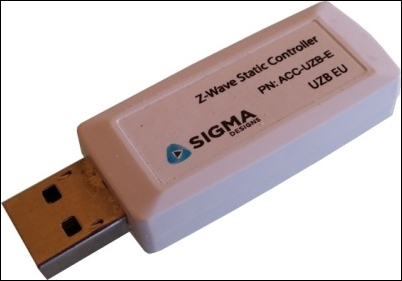Setting up the hardware
The Z-Wave technology, which is oriented to the residential control and automation market, is designed to be suitable for battery-operated devices. In fact, one of its main goals is to minimize the power consumption. Despite this fact, it provides reliable and low-latency transmission of small data packets at data rates of up to 100 kbps, and a simple yet reliable method to wirelessly manage sensors and control lights and appliances in a house.
Note
For more information on Z-Wave, a good starting point is at https://en.wikipedia.org/wiki/Z-Wave.
In our project, we're going to use a Z-Wave controller on a USB dongle, one slave device powered by the same plug where it's connected to, and one multisensor device that can be powered by batteries or via an external USB connection.
Setting up the Z-Wave controller
The Z-Wave controller I used in this prototype is shown in the following image:

Note
The device can be purchased at the following link (or by surfing the Internet): http...
























































